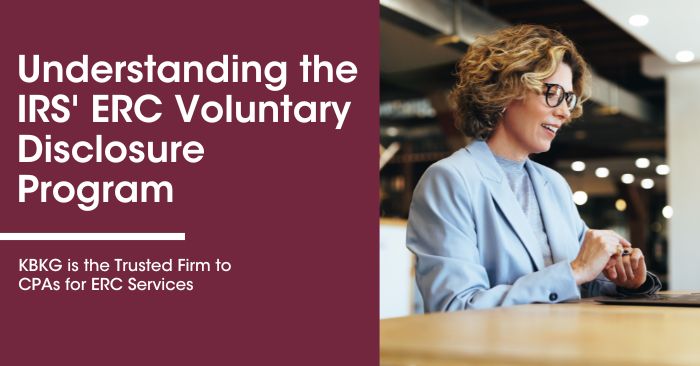Understanding the IRS' ERC Voluntary Disclosure Program
Thought Leadership by KBKG
The IRS’ introduction of the Employee Retention Credit Voluntary Disclosure Program (ERC-VDP) is a significant development that offers businesses, tax-exempt organizations, and government entities a chance to rectify any ineligible claims for the Employee Retention Credit (ERC). We summarize the key points from the IRS announcement and emphasize the approaching deadline for legitimate claims related to 2020 quarters.
KBKG’s Insight:
Legitimate ERC claims can move forward for any applicable quarter in 2020 by the 4/15/2024 deadline.
Companies with illegitimate ERC claims should consider the VDP as a measure to avoid potential IRS audits and the interest and penalties associated with a credit disallowance for an illegitimate claim.
Summary of IRS Announcement:
The ERC-VDP, open until March 22, 2024, provides an opportunity for those who claimed and received the ERC but later found themselves ineligible. Taxpayers can pay back 80% of an ERC claim without penalties. Cooperation with any IRS requests for additional information and signing a closing agreement is also mandatory. Eligibility checks can be conducted using the Employee Retention Credit Eligibility Checklist and the ERC-VDP FAQ. Working closely with a trusted tax professional is essential to navigate this process effectively.
Advantages of the ERC Voluntary Disclosure Program:
Participating in the ERC-VDP offers several benefits for those who mistakenly received the ERC:
- Repayment is required for only 80% of the received ERC.
- No repayment of interest received on the ERC refund.
- No need to amend income tax returns to reduce wage expenses.
- The 20% reduction is not taxable as income.
- The IRS will not impose penalties or interest if the total amount (claimed ERC minus 20%) is repaid when the signed closing agreement is returned to the IRS.
- The IRS won’t examine ERC on your employment tax return for resolved tax periods within the terms of ERC-VDP.
Who Can Apply to the ERC Voluntary Disclosure Program:
Businesses, tax-exempt organizations, and government entities can apply if they meet specific requirements:
- The ERC claim on an employment tax return has been processed and paid.
- You believe you were entitled to $0 ERC.
- Not under employment tax examination or criminal investigation by the IRS.
- No reversal or notification of intent to reverse ERC to $0 from the IRS.
Note: Third-party payers must apply for entities that use their services. Willful fraudulent claims may not be eligible for the ERC-VDP, and criminal investigation or prosecution may still be pursued.
How to Apply to the ERC Voluntary Disclosure Program:
Eligible entities must follow a structured application process, including:
- Completing Form 15434, Application for Employee Retention Credit Voluntary Disclosure Program.
- Preparing ERC-VDP Form SS-10, if applicable, for tax periods ending in 2020.
- Ensuring an authorized person signs the application and, if applicable, ERC-VDP Form SS-10.
- Submitting the application package using the IRS Document Upload Tool by 11:59 p.m. local time on March 22, 2024.
Entities unable to pay the full ERC-VDP amount may request an installment agreement using Form 433-B, Collection Information Statement for Businesses.
What Happens Next:
Upon receiving the application package, the IRS will review and verify eligibility. If approved:
- The IRS will mail a closing agreement.
- The full ERC-VDP amount must be paid using the IRS Electronic Federal Tax Payment System.
- If applicable, an authorized person must sign the closing agreement and Form 433-D.
- Return the forms to the IRS.
After receiving the signed closing agreement, the IRS will adjust the account to reflect the eliminated ERC amount. Notably, amended returns correcting ERC should not be submitted, as the terms of the ERC-VDP closing agreement are non-appealable.
Related Pages
- Supply Chain Disruption – How to Get Compliant for the ERC
- Employee Retention Tax Credit – Benefit Estimate
- Where is My Employee Retention Credit Refund?
- KBKG Tax Insight: IRS warns Taxpayers of Improper Employee Retention Credit Claims and ERC Mills
- KBKG Tax Insight: IRS To Target Abusive ERTC Claims. Analysis of Government Shutdown & Supply Chain Rules
- It’s Not Too Late to Claim Employee Retention Tax Credits
- The Employee Retention Tax Credit (ERC): What Small Businesses Need to Know


